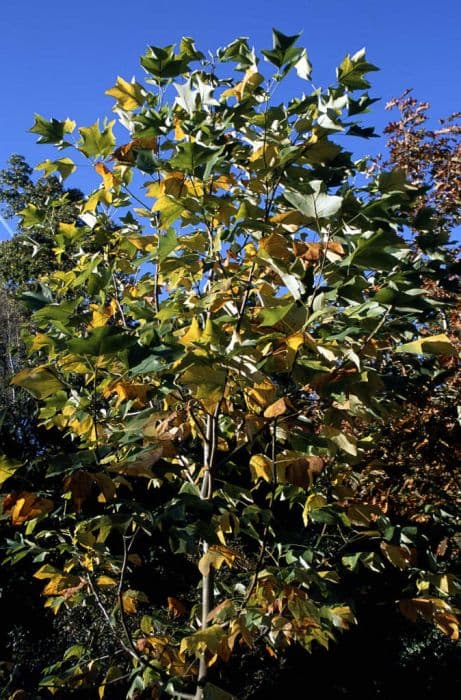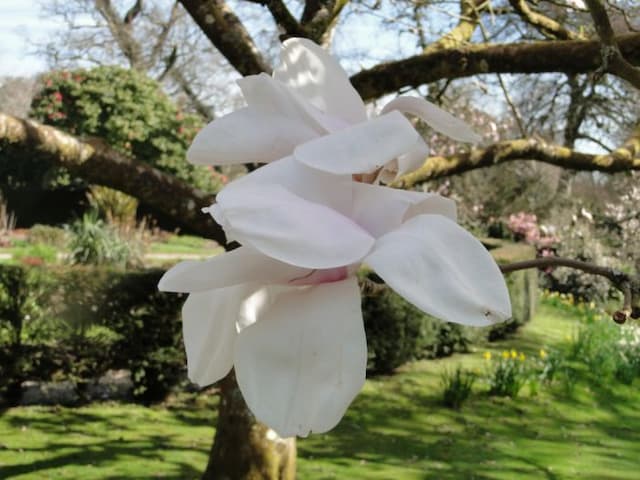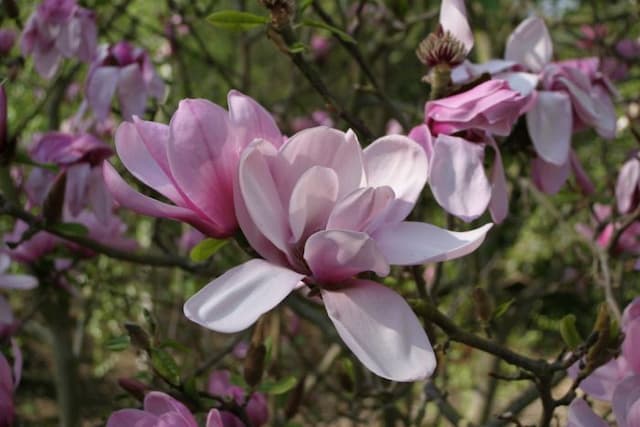Anise Magnolia Magnolia salicifolia

ABOUT
Magnolia salicifolia, commonly known as Anise Magnolia, has a distinctive and attractive appearance, characterized by its glossy, lance-shaped leaves that resemble those of willow trees. The leaves usually have a bright green color on the upper side and a lighter hue underneath. In spring, Anise Magnolia becomes even more striking with its showy flowers that are quite large and come in a creamy white to pale pink shade. These blossoms emanate a light, sweet fragrance reminiscent of anise, which gives the plant its common name. The flowers typically feature multiple petals that form an elegant, cup-like shape. As the plant matures, it produces cone-like fruiting structures that release individual red-coated seeds when ripe. The Anise Magnolia presents a graceful and aromatic addition to any garden, with its alluring flowers and pleasant scent being major highlights.
About this plant
 Names
NamesFamily
Magnoliaceae
Synonyms
Anise Magnolia, Willow-Leafed Magnolia
Common names
Magnolia biondii var. salicifolia, Yulania salicifolia.
 Toxicity
ToxicityTo humans
The plant commonly known as Anise Magnolia is not typically considered toxic to humans. There is limited information on the toxicity of Magnolia salicifolia to humans, and it is generally not associated with serious health problems if ingested. However, consuming any plant material can potentially cause adverse reactions in sensitive individuals, such as gastrointestinal discomfort, nausea, or allergic reactions. It is always advisable to exercise caution and avoid ingesting plants that are not specifically meant for consumption.
To pets
Similar to its effects on humans, the Anise Magnolia is not typically known to be toxic to pets either. However, as with any non-food plant, consumption of Magnolia salicifolia by pets may cause mild gastrointestinal upset, such as vomiting or diarrhea. If your pet ingests any part of this plant and shows adverse symptoms, it is best to consult a veterinarian. Always keep an eye on pets around plants, as individual animals can react differently, and some might be more sensitive to certain plant compounds than others.
 Characteristics
CharacteristicsLife cycle
Perennials
Foliage type
Deciduous
Color of leaves
Green
Flower color
White
Height
10-20 feet [3-6 meters]
Spread
6-10 feet [1.8-3 meters]
Plant type
Tree
Hardiness zones
5
Native area
Japan
Benefits
 General Benefits
General Benefits- Aesthetic Appeal: Magnolia salicifolia, commonly known as Anise Magnolia, has elegant and showy flowers that enhance the visual appeal of gardens and landscapes.
- Fragrance: The bloom of Anise Magnolia emits a delightful and soothing fragrance that can elevate the sensory experience of a garden space.
- Shade Provider: As a medium-sized tree, it can offer substantial shade in garden areas, making it a practical addition for sun protection.
- Habitat for Wildlife: The tree provides habitat and food for local wildlife, including birds and pollinating insects.
- Seasonal Interest: Anise Magnolia has a distinctive seasonal presence, with early spring blossoms and lush summer foliage, adding year-round interest to the environment.
- Durability: The species is known for being relatively hardy and able to withstand different environmental conditions once established.
 Medical Properties
Medical Properties- Anxiolytic effects: Some studies suggest that compounds found in Magnolia salicifolia (commonly known as anise magnolia) may have anxiolytic or anxiety-reducing properties.
- Antioxidant activity: Extracts from anise magnolia may possess antioxidant properties, which could help in protecting the body from oxidative stress.
- Anti-inflammatory properties: The plant is believed to contain compounds that may reduce inflammation, although more research is needed to confirm these effects.
- Neuroprotective potential: Early research indicates that anise magnolia might have neuroprotective effects, which could be beneficial for brain health.
- Anti-cancer activity: Some preliminary studies suggest that certain extracts of anise magnolia could have anti-cancer properties, but this use is not well-established and requires further investigation.
 Air-purifying Qualities
Air-purifying QualitiesThis plant is not specifically known for air purifying qualities.
 Other Uses
Other Uses- The wood of the Magnolia can be used in woodworking and cabinetry, due to its hardness and beautiful grain.
- Leaves from the Anise Magnolia are sometimes used in decorative arrangements or pressed for craft projects.
- The tree's bark has been used in tanning leather, providing tannins necessary in the process.
- Anise Magnolia's seed pods can be utilized as natural mulch in gardens after they decompose.
- The large, sturdy leaves can be used as natural wrappers for small gifts or as part of homemade potpourri.
- Fibers from the bark of the Magnolia salicifolia can be used in making ropes or coarse textiles.
- Dried and ground leaves of the Magnolia salicifolia can be used for creating natural dyes for fabrics.
- During blooming season, the fragrant flowers can be used to scent natural homemade candles and soaps.
- The flowers of the Anise Magnolia can be used to make a fragrant, natural air freshener by placing fresh flowers in a bowl of water.
- Artists can use the dark brown, cone-shaped seed pods as natural subjects for still life drawings or paintings.
Interesting Facts
 Feng Shui
Feng ShuiThe Anise Magnolia is not used in Feng Shui practice.
 Zodiac Sign Compitability
Zodiac Sign CompitabilityThe Anise Magnolia is not used in astrology practice.
 Plant Symbolism
Plant Symbolism- Persistence: The magnolia tree is known for its ability to withstand harsh conditions and still bloom beautifully, symbolizing endurance and strength to persist through difficulties.
- Dignity: With its impressive stance and grandiose blooms, the magnolia represents a dignified and noble spirit, often related to a person's self-respect and worth.
- Feminine beauty: The delicate yet striking appearance of the magnolia flower is often associated with purity and the refined beauty of a woman.
- Love of nature: Given the magnolia's deep roots in the earth and its expansive branches, it is frequently seen as a symbol of one's deep connection and love for the natural world.
- Perseverance: Similar to persistence, the magnolia's long history and capacity to bloom year after year symbolizes the perseverance to overcome obstacles.
 Water
WaterThe Anise Magnolia requires consistent moisture, especially during the growing season. It should be watered thoroughly, allowing the water to penetrate deep into the root zone. Watering should be done weekly, providing about 1 to 1.5 gallons of water for younger trees and 2 to 3 gallons for established ones, depending on weather conditions. During hot and dry spells, the frequency should increase to twice a week. In winter, reduce watering to match the plant's slower growth and evaporation rates.
 Light
LightAnise Magnolia thrives best in full sun to partial shade. It should be placed in a location where it can receive at least four hours of direct sunlight daily, though it will appreciate some afternoon shade in hotter climates. An east or west-facing spot that avoids the intense mid-day sun can also be ideal for this magnolia variety.
 Temperature
TemperatureAnise Magnolia is hardy in a range of temperatures and can survive minimum winter temperatures down to about -10°F to -20°F. The ideal growing temperatures for this plant are between 65°F and 75°F during the day, with cooler nighttime temperatures. However, it is important to avoid exposure to temperatures above 90°F for prolonged periods, as this can stress the plant.
 Pruning
PruningAnise Magnolia benefits from light pruning to maintain shape and remove any dead or damaged wood. Pruning should be done after the tree has finished flowering, typically in late spring or early summer. Annual pruning is usually sufficient; however, if necessary, larger branches can be pruned back in mid-winter when the tree is dormant.
 Cleaning
CleaningAs needed
 Soil
SoilWillowleaf Magnolia thrives in a moist, well-draining soil mix that is rich in organic matter. The ideal pH for this plant is slightly acidic to neutral, ranging from 5.5 to 7.0. An excellent soil mix might consist of two parts loam, one part peat moss, and one part perlite or fine pine bark to ensure good drainage and aeration.
 Repotting
RepottingWillowleaf Magnolia should be repotted every 2-3 years or when it outgrows its current container. It is best to repot this plant in the spring, just before the growing season begins.
 Humidity & Misting
Humidity & MistingWillowleaf Magnolia prefers average to high humidity levels. To thrive, it should be kept in an environment where the humidity level is around 50-70%.
 Suitable locations
Suitable locationsIndoor
Place Willowleaf Magnolia near a bright window and keep soil moist.
Outdoor
Plant in partial shade, shelter from wind, and maintain moist soil.
Hardiness zone
5-8 USDA
 Life cycle
Life cycleMagnolia salicifolia, commonly known as Anise Magnolia, begins its life as a seed, which after stratification, germinates in the spring. The seedling develops into a juvenile plant with a primary shoot that grows upward and roots that spread to absorb nutrients and water. As the plant matures, it develops woody stems and branches, forming a tree that can reach up to 10 meters in height. Anise Magnolia then enters its reproductive stage, producing fragrant white or cream-colored flowers, typically from March to April, which are pollinated by insects. After fertilization, the plant develops cone-like fruit that contains the seeds, which are dispersed by wind or animal activity. Finally, the plant reaches senescence, where growth slows, and it may become less productive in flowering and seeding until it eventually dies.
 Propogation
PropogationPropogation time
Spring to Summer
The Magnolia salicifolia, commonly known as Anise Magnolia, is usually best propagated by semi-hardwood cuttings. This method is most successful when performed in summer, as the plant is actively growing and the cuttings are more likely to root. You would take a cutting of about 4 to 6 inches (10 to 15 centimeters) from a healthy branch, making sure it has at least two to three leaf nodes. The bottom cut should be just below a leaf node, and the top cut just above a leaf node, ensuring you have a few leaves on the cutting. The leafy top helps with photosynthesis and the nodes are where roots are more likely to form. Dip the cut end in rooting hormone to encourage root growth, then plant the cutting in a pot with well-draining soil, like a mix of peat and perlite. Keep the soil consistently moist and covered with a plastic bag or dome to maintain humidity until roots develop which usually takes a few weeks to a few months.









![Magnolia [Felix Jury]](/_next/image?url=https%3A%2F%2Fplants-admin.emdemapps.com%2Fimages%2Fplants%2F%2Fimages%2F604b61a0b23b7.png&w=640&q=75)